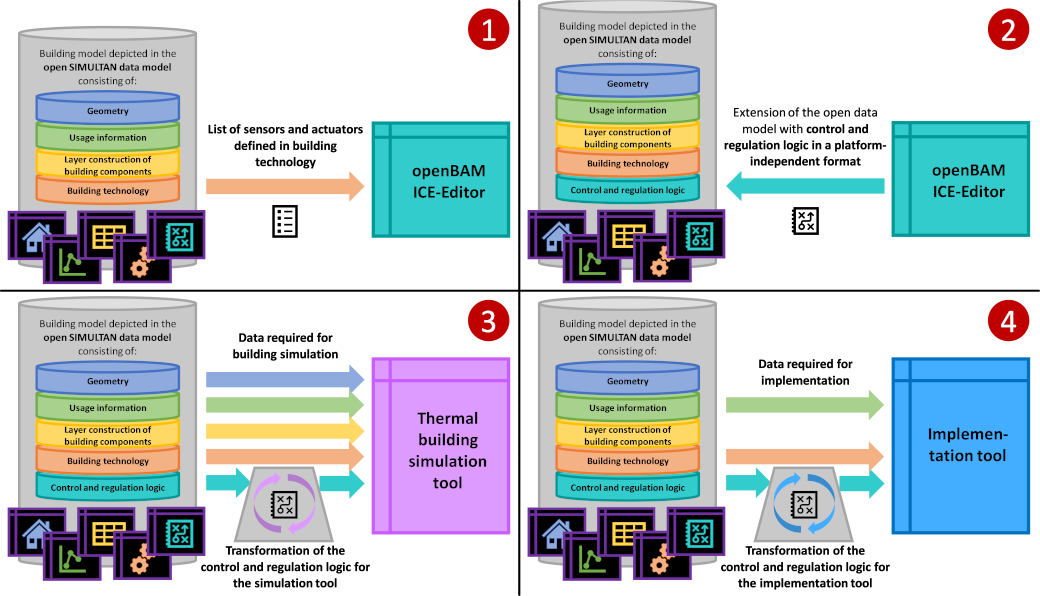openBAM - Open Building Automation Modelling - Open modeling of building automation over the entire building life cycle
Short Description
Starting point / motivation
Efficient buildings, i.e., buildings where entire energy consumption (building operation and use) can be covered by local energy generation, are essential elements of climate-neutral cities or urban districts. These plus-plus-energy buildings have already been implemented in practice in various forms. Still, many projects have shown that their actual energy consumption is higher than the initially planned consumption. One of the reasons for this can be traced back to the fact that building automation is not planned in detail until the buildings are commissioned. Due to this reason, and due to lack of time and budget, the entire energy savings potential that building automation could provide is rarely realized. Thus, buildings consume more energy than necessary.
Contents and goals
Since every kilowatt-hour of energy not consumed contributes to achieving the goal of "climate neutrality", buildings with well-designed and perfectly operating building automation systems are needed to ensure optimal building performance. Otherwise, highly efficient buildings can result in unnecessary additional energy consumption of up to 54%. To design the building automation - particularly the control and regulation logic - for optimal operation in advance, it must be developed based on a digital, simulation-capable representation (digital twin). All relevant aspects of the building (control logic, utilization information, geometry, structural engineering, and building services engineering) should be mapped in various degrees of detail - from simplified to very detailed - to ensure target-oriented planning.
Methods
In the project, a method for platform-independent modeling of the control and regulation logic will be created and integrated into an open data model. This allows the control logic to be linked to the components and parameters of building models already in the planning phase and over the entire building life cycle. The IT ecosystem SIMULTAN is used as a proof-of-concept, providing a platform for open data models such as IFC (ISO 16739) and BACNET (ISO 16484).
Based on this, interfaces are methodically developed to transfer the platform-independent modeled control logic into platform-specific solutions (e.g., simulation tools, engineering tools). The practical suitability of the methodology is demonstrated by application in a laboratory scenario.
Results and conclusions
In the project, the planning of the building automation was implemented using a generic, technology-independent methodology. The openBAM Editor enables the modeling of control logic using UML state graphs. To support building automation over the entire building life cycle, the logic mapping was linked to the digital building model, which is stored in an open data model via consistent data points. Model transformations are used to process the information further in simulation and engineering tools. A laboratory test setup of a ventilation system was used to show that modeling is possible, starting in the digital world of Simultan, including the use of a simulation, and ending in the SAUTER control system. Consistent modeling of the control logic is guaranteed. This allows the control logic to be developed independently of the target system (SAUTER) in the early design phase and optimized using simulations (IDA ICE) to create a basis for subsequent energy consumption. The optimized design can then be implemented in the execution phase (SAUTER Engineering) without any loss of information.
Outlook
The research project identified potential for future developments. A key point is that new modeling or manual adjustments are required when data points used in logic modeling are changed or deleted. In the future, notification mechanisms and repositories or version controls should be established to track changes and inform users of them. In addition, it was found that modeling complex control logic can be challenging, as many parallel processes are involved, and the state graphs can quickly become very large. In this area, among other things, it is necessary to optimize the display.
Project Partners
Project management
Institute of Material Technology, Building Physics, and Building Ecology, TU Wien
Project or cooperation partners
- Institute of Computer Engineering, TU Wien
- Sauter Meß- und Regeltechnik Gesellschaft m.b.H.
Contact Address
Prof. Thomas Bednar
Karlsplatz 13, E207-02
A-1030 Vienna
Tel.: +43 (1) 58801 207201
E-Mail: thomas.bednar@tuwien.ac.at
Web: www.bph.tuwien.ac.at

